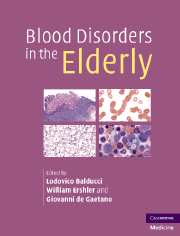Book contents
- Frontmatter
- Contents
- List of contributors
- Preface
- Part I Epidemiology
- Part II Hematopoiesis
- Part III Anemia of aging
- 12 Erythropoietin and aging
- 13 Iron and aging
- 14 Prevalence and mechanisms of B12 deficiency
- 15 Consequences of chronic anemia in the older person
- 16 The pathogenesis of late-life anemia
- 17 Treatment of late-life anemia
- Part IV Hematologic malignancies and aging
- Part V Disorders of hemostasis in the elderly
- Index
15 - Consequences of chronic anemia in the older person
from Part III - Anemia of aging
Published online by Cambridge University Press: 21 October 2009
- Frontmatter
- Contents
- List of contributors
- Preface
- Part I Epidemiology
- Part II Hematopoiesis
- Part III Anemia of aging
- 12 Erythropoietin and aging
- 13 Iron and aging
- 14 Prevalence and mechanisms of B12 deficiency
- 15 Consequences of chronic anemia in the older person
- 16 The pathogenesis of late-life anemia
- 17 Treatment of late-life anemia
- Part IV Hematologic malignancies and aging
- Part V Disorders of hemostasis in the elderly
- Index
Summary
Introduction
Anemia, whose prevalence and incidence increase with age, has been associated with a number of adverse outcomes in older individuals. It is attractive to hypothesize that the reversal of anemia may effect compression of morbidity, which is the main goal of geriatric medicine. More prolonged health and independence may improve the quality of life and reduce the management cost of the older aged person.
After studying the epidemiology of anemia and aging, this chapter explores the adverse consequences of anemia in the elderly and the outcomes of anemia management.
Epidemiology and causes of anemia in older age
Definition of anemia
The World Health Organization (WHO) defines anemia as hemoglobin levels lower than 12 g/dL in women and 13.5 g/dL in men. In older people, however, this definition should be revised based on two types of findings:
People of different ethnic origins may have different levels of hemoglobin in homeostatic conditions. In the NHANES III study, the prevalence of anemia was much higher among older African-Americans than among white, Asian, or Hispanic elderly (Fig. 15.1). In the same database Patel et al. demonstrated that mild anemia was not associated with adverse outcomes in blacks. These findings suggest that hemoglobin levels may be lower in black individuals than in other ethnic groups in normal conditions.
[…]
- Type
- Chapter
- Information
- Blood Disorders in the Elderly , pp. 192 - 202Publisher: Cambridge University PressPrint publication year: 2007



